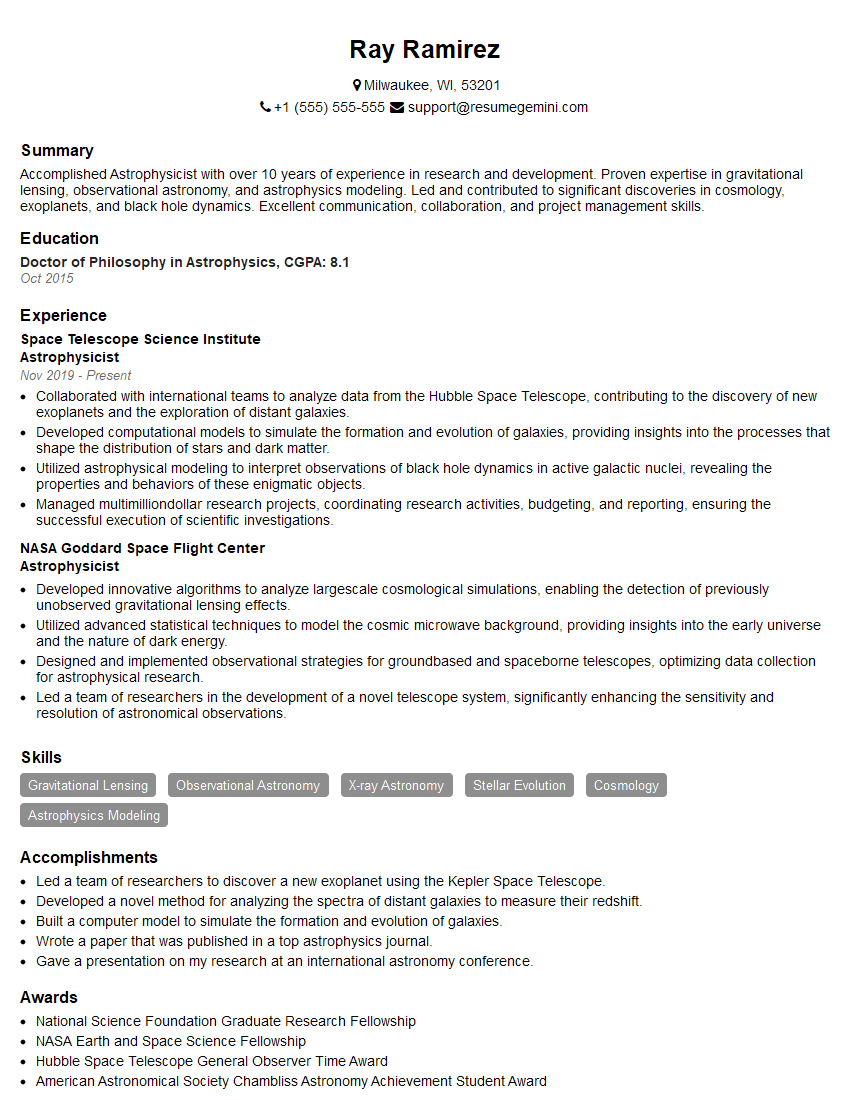Feeling uncertain about what to expect in your upcoming interview? We’ve got you covered! This blog highlights the most important Basic Chemistry and Physics interview questions and provides actionable advice to help you stand out as the ideal candidate. Let’s pave the way for your success.
Questions Asked in Basic Chemistry and Physics Interview
Q 1. Explain the difference between ionic and covalent bonds.
Ionic and covalent bonds are two fundamental types of chemical bonds that hold atoms together in molecules and compounds. The key difference lies in how the atoms share electrons.
- Ionic Bonds: These bonds form through the electrostatic attraction between oppositely charged ions. One atom loses electrons (becoming a positively charged cation), and another atom gains those electrons (becoming a negatively charged anion). Think of it like a magnet – opposite charges attract strongly. A classic example is sodium chloride (NaCl), where sodium (Na) loses an electron to become Na+ and chlorine (Cl) gains that electron to become Cl–, forming a strong ionic bond.
- Covalent Bonds: In covalent bonds, atoms share electrons to achieve a stable electron configuration. Instead of a complete transfer of electrons, atoms share one or more pairs of electrons, creating a bond that holds them together. Water (H2O) is a great example: each hydrogen atom shares an electron pair with the oxygen atom, forming two covalent bonds.
The difference is also reflected in their properties. Ionic compounds generally have high melting and boiling points, are often soluble in water, and conduct electricity when dissolved or molten. Covalent compounds, on the other hand, tend to have lower melting and boiling points, are often insoluble in water, and usually do not conduct electricity.
Q 2. What is the ideal gas law and under what conditions does it hold?
The Ideal Gas Law is a mathematical relationship that describes the behavior of an ideal gas. An ideal gas is a theoretical gas composed of randomly moving particles that do not interact except for perfectly elastic collisions. It’s represented by the equation: PV = nRT
P: Pressure of the gasV: Volume of the gasn: Number of moles of gasR: Ideal gas constant (a constant that depends on the units used)T: Temperature of the gas in Kelvin
This law holds true under specific conditions: low pressure and high temperature. At low pressures, the gas particles are far apart, minimizing intermolecular interactions. At high temperatures, the kinetic energy of the particles is high enough to overcome any weak attractive forces. At high pressure and low temperature, real gases deviate significantly from ideal gas behavior because intermolecular forces become more important.
Understanding the Ideal Gas Law is crucial in many applications, from designing engines to predicting weather patterns. For example, chemists use it to calculate the amount of gas produced in a chemical reaction or the volume of gas needed for a particular experiment.
Q 3. Describe the process of electrolysis.
Electrolysis is the process of using direct electric current (DC) to drive a non-spontaneous chemical reaction. It’s essentially the reverse of a voltaic cell (battery).
In electrolysis, an external voltage is applied to an electrolytic cell containing an electrolyte (a substance that conducts electricity when dissolved in water or molten). The electrolyte contains ions, which are attracted to the electrodes (positive anode and negative cathode) based on their charge.
- At the cathode (negative electrode): Cations (positively charged ions) are reduced (they gain electrons).
- At the anode (positive electrode): Anions (negatively charged ions) are oxidized (they lose electrons).
A classic example is the electrolysis of water. When an electric current is passed through water containing a small amount of electrolyte (to increase conductivity), water molecules decompose into hydrogen gas at the cathode and oxygen gas at the anode. 2H2O(l) → 2H2(g) + O2(g)
Electrolysis has numerous applications, including the production of metals (like aluminum), electroplating, and the purification of water.
Q 4. What are the different states of matter and how do they interconvert?
Matter exists in various states, primarily solid, liquid, and gas. The state is determined by the strength of the intermolecular forces between particles and their kinetic energy.
- Solid: Particles are tightly packed in a fixed arrangement, resulting in a definite shape and volume. Strong intermolecular forces restrict movement.
- Liquid: Particles are close together but can move around, resulting in a definite volume but an indefinite shape (it takes the shape of its container). Intermolecular forces are weaker than in solids.
- Gas: Particles are widely spaced and move randomly, resulting in indefinite shape and volume. Weak intermolecular forces allow free movement.
- Plasma: A high-energy state where electrons are stripped from atoms, forming ions. Plasma is not as common in everyday life but is found in stars and lightning.
These states interconvert through changes in temperature and pressure. Adding heat increases kinetic energy, leading to transitions from solid to liquid (melting), liquid to gas (boiling/vaporization), and solid to gas (sublimation). Removing heat causes the reverse transitions (freezing, condensation, and deposition).
Q 5. Explain the concept of molarity and molality.
Molarity and molality are both ways to express the concentration of a solution, but they differ in how they define the amount of solvent.
- Molarity (M): Molarity is defined as the number of moles of solute per liter of solution (solute + solvent).
Molarity (M) = moles of solute / liters of solution. For example, a 1 M solution of NaCl contains 1 mole of NaCl dissolved in 1 liter of the solution (the total volume of NaCl and water combined). - Molality (m): Molality is defined as the number of moles of solute per kilogram of solvent.
Molality (m) = moles of solute / kilograms of solvent. A 1 m solution of NaCl contains 1 mole of NaCl dissolved in 1 kilogram of water (only the water’s weight is considered).
The difference becomes significant when dealing with solutions where the volume changes significantly with temperature. Molarity changes with temperature, while molality is temperature-independent since it’s based on mass.
Q 6. What is the difference between endothermic and exothermic reactions?
Endothermic and exothermic reactions are classified based on their heat transfer with the surroundings.
- Exothermic Reactions: These reactions release heat to their surroundings. The enthalpy change (ΔH) is negative, indicating a decrease in the system’s energy. Many combustion reactions are exothermic, like burning wood or natural gas, which releases heat and light.
- Endothermic Reactions: These reactions absorb heat from their surroundings. The enthalpy change (ΔH) is positive, indicating an increase in the system’s energy. Melting ice is an endothermic process; heat is absorbed from the surroundings to break the bonds in ice.
Imagine exothermic reactions like a bonfire – they give off heat. Endothermic reactions are like melting ice; they require heat input.
Q 7. Define enthalpy and entropy.
Enthalpy and entropy are thermodynamic state functions that describe the energy and disorder of a system.
- Enthalpy (H): Enthalpy is the total heat content of a system at constant pressure. It represents the system’s internal energy plus the product of its pressure and volume. The change in enthalpy (ΔH) during a reaction indicates the amount of heat transferred at constant pressure. A negative ΔH suggests an exothermic reaction (heat released), and a positive ΔH suggests an endothermic reaction (heat absorbed).
- Entropy (S): Entropy is a measure of the randomness or disorder of a system. A system with high entropy is more disordered than one with low entropy. The change in entropy (ΔS) during a process indicates the change in disorder. A positive ΔS indicates an increase in disorder, while a negative ΔS indicates a decrease in disorder.
These concepts are crucial in predicting the spontaneity of reactions. The Gibbs free energy (G), defined as G = H – TS (where T is temperature in Kelvin), combines enthalpy and entropy to determine whether a reaction will occur spontaneously.
Q 8. Explain Newton’s three laws of motion.
Newton’s three laws of motion are fundamental principles in classical mechanics that describe the relationship between a body and the forces acting upon it, and its motion in response to those forces. They form the basis for understanding how objects move.
Newton’s First Law (Inertia): An object at rest stays at rest and an object in motion stays in motion with the same speed and in the same direction unless acted upon by an unbalanced force. Think of a hockey puck on frictionless ice – it will continue sliding indefinitely unless a stick or something else acts upon it.
Newton’s Second Law (F=ma): The acceleration of an object is directly proportional to the net force acting on the object, is in the same direction as the net force, and is inversely proportional to the mass of the object. This is often expressed as the equation
F = ma, where F is force, m is mass, and a is acceleration. For example, a heavier car requires a more powerful engine (greater force) to achieve the same acceleration as a lighter car.Newton’s Third Law (Action-Reaction): For every action, there is an equal and opposite reaction. When one object exerts a force on a second object, the second object simultaneously exerts a force equal in magnitude and opposite in direction on the first object. Consider a rocket launching: the rocket expels hot gas downwards (action), and the gas exerts an equal and opposite force upwards on the rocket (reaction), propelling it into space.
Q 9. What is the relationship between force, mass, and acceleration?
The relationship between force, mass, and acceleration is described by Newton’s Second Law of Motion: F = ma. This equation tells us that the force (F) acting on an object is equal to the product of its mass (m) and its acceleration (a). A larger force will result in a greater acceleration, while a larger mass will result in a smaller acceleration for the same force. For instance, pushing a shopping cart (small mass) requires less force to achieve a certain acceleration than pushing a car (large mass).
Q 10. Describe the concept of energy conservation.
The principle of energy conservation states that energy cannot be created or destroyed, only transformed from one form to another. The total energy of an isolated system remains constant. Imagine a pendulum swinging: at its highest point, it possesses potential energy (stored energy due to its position). As it swings down, this potential energy converts into kinetic energy (energy of motion). At the bottom, it has maximum kinetic energy and minimum potential energy. The total energy (potential + kinetic) remains constant, ignoring minor energy losses due to friction and air resistance.
Q 11. What are the different types of energy?
Energy exists in various forms, including:
- Kinetic Energy: Energy of motion (e.g., a moving car).
- Potential Energy: Stored energy due to position or configuration (e.g., a stretched spring, water behind a dam).
- Thermal Energy: Energy associated with temperature (e.g., heat from a fire).
- Chemical Energy: Energy stored in chemical bonds (e.g., energy released when burning wood).
- Nuclear Energy: Energy stored in the nucleus of an atom (e.g., energy from nuclear fission or fusion).
- Radiant Energy: Energy that travels in waves (e.g., light and other electromagnetic radiation).
- Electrical Energy: Energy associated with the flow of electric charge (e.g., electricity powering a light bulb).
These forms of energy can be interconverted; for example, a hydroelectric power plant converts potential energy (water stored behind a dam) into kinetic energy (flowing water) and then into electrical energy.
Q 12. Explain the concept of momentum.
Momentum is a measure of an object’s mass in motion. It is calculated as the product of an object’s mass and its velocity: p = mv, where p is momentum, m is mass, and v is velocity. Momentum is a vector quantity, meaning it has both magnitude and direction. A heavier object moving at the same speed as a lighter object has greater momentum. This concept is crucial in understanding collisions; in a closed system, the total momentum before a collision is equal to the total momentum after the collision (conservation of momentum).
Q 13. What is the difference between speed and velocity?
Speed and velocity are both measures of how fast an object is moving, but they differ in that velocity includes direction while speed does not. Speed is a scalar quantity (magnitude only), while velocity is a vector quantity (magnitude and direction). For example, a car traveling at 60 mph is its speed. If we specify it’s traveling 60 mph North, that’s its velocity.
Q 14. Describe the concept of simple harmonic motion.
Simple harmonic motion (SHM) is a type of periodic motion where the restoring force is directly proportional to the displacement and acts in the direction opposite to that of displacement. This means the force always tries to pull the object back to its equilibrium position. A classic example is a mass attached to a spring. When displaced, the spring exerts a force proportional to the displacement, causing the mass to oscillate back and forth. The motion is characterized by a constant period (time taken for one complete oscillation) and is described by sinusoidal functions (sine or cosine waves). The motion of a simple pendulum (for small angles) is also an approximate example of SHM.
Q 15. What is the difference between transverse and longitudinal waves?
The key difference between transverse and longitudinal waves lies in the direction of oscillation relative to the direction of wave propagation.
Transverse waves: The particles of the medium oscillate perpendicular to the direction the wave travels. Imagine shaking a rope up and down; the wave moves horizontally, but the rope itself moves vertically. Light is a classic example of a transverse wave.
Longitudinal waves: The particles oscillate parallel to the direction of wave propagation. Think of a slinky being pushed and pulled; the compression and rarefaction (spreading out) of the coils move along the slinky’s length, and the coils themselves move back and forth in the same direction.
A simple way to remember this is: Transverse waves are like a snake moving sideways, while longitudinal waves are like a train moving forward.
Practical Application: Understanding this distinction is crucial in various fields, such as seismology (analyzing earthquake waves), ultrasonography (using sound waves for medical imaging), and optics (studying light waves).
Career Expert Tips:
- Ace those interviews! Prepare effectively by reviewing the Top 50 Most Common Interview Questions on ResumeGemini.
- Navigate your job search with confidence! Explore a wide range of Career Tips on ResumeGemini. Learn about common challenges and recommendations to overcome them.
- Craft the perfect resume! Master the Art of Resume Writing with ResumeGemini’s guide. Showcase your unique qualifications and achievements effectively.
- Don’t miss out on holiday savings! Build your dream resume with ResumeGemini’s ATS optimized templates.
Q 16. Explain the Doppler effect.
The Doppler effect describes the change in frequency or wavelength of a wave (like sound or light) for an observer who is moving relative to the source of the wave. It’s why a siren sounds higher pitched as it approaches and lower pitched as it moves away.
Explanation: As the source moves closer, the waves are compressed, leading to a shorter wavelength and higher frequency (higher pitch for sound, bluer light for light). Conversely, as the source moves away, the waves are stretched, resulting in a longer wavelength and lower frequency (lower pitch for sound, redder light for light).
The magnitude of the Doppler shift depends on the relative speeds of the source and observer and the speed of the wave in the medium. It’s described mathematically by specific equations, varying slightly depending on whether the source, observer, or both are moving.
Practical Application: The Doppler effect is used in:
- Speed guns: Measuring the speed of vehicles by analyzing the Doppler shift of radar waves.
- Astronomy: Determining the movement of stars and galaxies by observing the redshift (moving away) or blueshift (moving closer) of their light.
- Medical imaging: Doppler ultrasound uses the Doppler effect to visualize blood flow and its velocity.
Q 17. What is the photoelectric effect?
The photoelectric effect is the emission of electrons when light hits a material. Crucially, this only occurs if the light’s frequency is above a certain threshold, regardless of intensity.
Explanation: Light behaves as both a wave and a particle (photon). Each photon carries energy proportional to its frequency (E = hf, where h is Planck’s constant and f is frequency). When a photon strikes a material, it can transfer its energy to an electron. If the photon’s energy is greater than the electron’s binding energy (work function) to the material, the electron is ejected. If the frequency is too low (even with high intensity), no electrons are emitted because individual photons lack sufficient energy.
Practical Application: The photoelectric effect is fundamental to many technologies, including:
- Photocells: Used in light meters, solar cells, and various sensors.
- Image sensors: In digital cameras and other imaging devices.
Q 18. Explain the concept of radioactivity.
Radioactivity is the spontaneous emission of particles or energy from the nucleus of an unstable atom to become more stable. This instability arises from an imbalance in the number of protons and neutrons in the nucleus.
Explanation: Unstable nuclei undergo radioactive decay, transforming into a different nuclide (atom with a different number of protons or neutrons). This decay process releases energy in the form of alpha particles (helium nuclei), beta particles (electrons or positrons), or gamma rays (high-energy photons).
Types of Decay:
- Alpha decay: Emission of an alpha particle (2 protons and 2 neutrons).
- Beta decay: Emission of a beta particle (an electron or positron).
- Gamma decay: Emission of a gamma ray (high-energy photon).
Practical Application: Radioactivity has applications in:
- Medicine: Radioactive isotopes are used in diagnosis (e.g., PET scans) and treatment (e.g., radiotherapy).
- Industry: Radioactive tracers are used to monitor industrial processes.
- Archaeology: Radiocarbon dating is used to determine the age of organic materials.
Q 19. What are the different types of nuclear reactions?
Nuclear reactions involve changes in the nucleus of an atom. They are broadly classified into several types:
Nuclear fission: The splitting of a heavy nucleus into two lighter nuclei, releasing a large amount of energy. This is the process used in nuclear power plants and atomic bombs.
Nuclear fusion: The combining of two light nuclei into a heavier nucleus, also releasing a large amount of energy. This is the process that powers the sun and stars.
Radioactive decay: The spontaneous emission of particles or energy from an unstable nucleus (as explained earlier).
Nuclear transmutation: The conversion of one nuclide into another through bombardment with particles (e.g., neutrons or protons).
Practical Application: The different types of nuclear reactions have diverse applications, as mentioned previously, spanning energy production, medicine, and scientific research.
Q 20. Describe the structure of an atom.
The atom is composed of three primary subatomic particles:
Protons: Positively charged particles located in the nucleus.
Neutrons: Neutrally charged particles also located in the nucleus.
Electrons: Negatively charged particles orbiting the nucleus in electron shells or orbitals.
The number of protons defines the element (atomic number). The number of protons plus neutrons equals the mass number. Electrons are much lighter than protons and neutrons and occupy a much larger volume relative to the nucleus. The atom is mostly empty space.
Models of the Atom: Our understanding of the atom’s structure has evolved over time, starting from simple models (like the plum pudding model) to the current quantum mechanical model, which describes electron behavior probabilistically in orbitals.
Q 21. What are isotopes?
Isotopes are atoms of the same element that have the same number of protons but a different number of neutrons. This means they have the same atomic number but different mass numbers.
Example: Carbon-12 (12C) and Carbon-14 (14C) are isotopes of carbon. Both have 6 protons, but 12C has 6 neutrons, while 14C has 8 neutrons. 14C is radioactive, while 12C is stable.
Practical Application: Isotopes are used extensively in various fields, including:
- Radioactive Dating: As mentioned earlier, 14C dating is used to estimate the age of organic materials.
- Medical Tracers: Radioactive isotopes are used to trace biological processes in the body.
- Nuclear Medicine: Isotopes like iodine-131 are used in the treatment of certain medical conditions.
Q 22. Explain the concept of pH and pOH.
pH and pOH are measures of the acidity or alkalinity of a solution. They’re based on the concentration of hydrogen ions (H+) and hydroxide ions (OH–), respectively, in a solution. A lower pH indicates a higher concentration of H+ ions, meaning the solution is more acidic. A higher pH indicates a lower concentration of H+ ions, meaning the solution is more alkaline (or basic).
pH is calculated using the negative logarithm (base 10) of the hydrogen ion concentration: pH = -log10[H+]. For example, a solution with a hydrogen ion concentration of 1 x 10-4 M has a pH of 4. Conversely, pOH is calculated using the negative logarithm of the hydroxide ion concentration: pOH = -log10[OH-]. In aqueous solutions at 25°C, pH and pOH are related by the equation: pH + pOH = 14. This relationship arises from the ion product constant of water (Kw).
Think of it like this: Imagine a scale from 0 to 14. 0 is extremely acidic (like battery acid), 7 is neutral (like pure water), and 14 is extremely alkaline (like drain cleaner). pH and pOH help us precisely quantify this acidity or alkalinity.
Q 23. What are buffers and how do they work?
Buffers are solutions that resist changes in pH upon the addition of small amounts of acid or base. They’re crucial in maintaining a stable pH in many biological and chemical systems. A buffer typically consists of a weak acid and its conjugate base (or a weak base and its conjugate acid).
How they work: When a small amount of acid is added to a buffer, the conjugate base reacts with the added H+ ions, minimizing the change in pH. Conversely, when a small amount of base is added, the weak acid in the buffer reacts with the added OH– ions, again minimizing the pH change. This ability to neutralize both acids and bases is the essence of a buffer’s effectiveness.
A classic example is the acetic acid/acetate buffer system. Acetic acid (CH3COOH) is a weak acid, and its conjugate base is acetate (CH3COO–). This buffer system is used in many laboratory settings and industrial processes to maintain a relatively constant pH.
Q 24. Describe the process of titration.
Titration is a quantitative analytical technique used to determine the concentration of an unknown solution (analyte) by reacting it with a solution of known concentration (titrant). This is done by gradually adding the titrant to the analyte while monitoring the change in pH or some other relevant property of the solution.
The process involves using a burette to precisely deliver the titrant to the analyte. The point at which the reaction is complete is called the equivalence point. This point is often visually detected using an indicator that changes color at or near the equivalence point. The volume of titrant used to reach the equivalence point is then used to calculate the concentration of the analyte using stoichiometric relationships.
For instance, if you’re titrating a strong acid with a strong base, the equivalence point will be at a pH of 7. However, if you titrate a weak acid with a strong base, the equivalence point will be above pH 7.
Q 25. What are the different types of chemical reactions?
Chemical reactions can be categorized in several ways. Here are some of the most common types:
- Combination (Synthesis): Two or more substances combine to form a single, more complex substance. Example:
2H2 + O2 → 2H2O - Decomposition: A single compound breaks down into two or more simpler substances. Example:
2H2O → 2H2 + O2 - Single Displacement (Replacement): One element replaces another in a compound. Example:
Zn + 2HCl → ZnCl2 + H2 - Double Displacement (Metathesis): Two compounds exchange ions to form two new compounds. Example:
AgNO3 + NaCl → AgCl + NaNO3 - Combustion: A substance rapidly reacts with oxygen, often producing heat and light. Example:
CH4 + 2O2 → CO2 + 2H2O - Acid-Base Reactions (Neutralization): An acid reacts with a base to form salt and water. Example:
HCl + NaOH → NaCl + H2O
These are just some of the fundamental types; many reactions can be classified under multiple categories.
Q 26. Explain the concept of stoichiometry.
Stoichiometry is the quantitative relationship between reactants and products in a chemical reaction. It’s based on the law of conservation of mass, which states that matter cannot be created or destroyed in a chemical reaction. Therefore, the total mass of reactants must equal the total mass of products.
Stoichiometric calculations use balanced chemical equations to determine the amount of reactants needed or products formed in a reaction. This involves using mole ratios from the balanced equation to convert between moles of reactants and moles of products. For example, in the reaction 2H2 + O2 → 2H2O, the mole ratio of hydrogen to water is 2:2 (or 1:1). If you know the moles of hydrogen used, you can calculate the moles of water produced using this ratio.
Stoichiometry is essential in many areas, including industrial chemical processes, pharmaceutical manufacturing, and environmental analysis, to ensure efficient and accurate reactions.
Q 27. How do you calculate the density of a substance?
The density of a substance is its mass per unit volume. It’s a fundamental property that helps identify and characterize materials. The formula for calculating density is:
Density (ρ) = Mass (m) / Volume (V)
To calculate the density, you need to measure both the mass and volume of the substance. Mass is typically measured using a balance, while volume can be measured using various methods depending on the state of the substance (e.g., graduated cylinder for liquids, water displacement for irregular solids).
For example, if a sample of a liquid has a mass of 50 grams and a volume of 25 milliliters, its density would be: ρ = 50 g / 25 mL = 2 g/mL
Q 28. What is the difference between precision and accuracy?
Precision and accuracy are two distinct but related concepts in measurement. Accuracy refers to how close a measured value is to the true or accepted value. Precision refers to how close repeated measurements are to each other. A simple analogy is using a dartboard:
High accuracy, high precision: All darts are clustered tightly near the bullseye.
High precision, low accuracy: All darts are clustered tightly together, but far from the bullseye.
Low precision, low accuracy: Darts are scattered randomly across the board.
High accuracy, low precision: Darts are scattered around the bullseye, but not clustered tightly.
In scientific work, both precision and accuracy are essential for reliable results. High precision indicates minimal random error, while high accuracy indicates minimal systematic error.
Key Topics to Learn for Basic Chemistry and Physics Interview
- Atomic Structure and Bonding: Understand atomic orbitals, electron configurations, and the different types of chemical bonds (ionic, covalent, metallic). Consider practical applications in material science and drug design.
- Stoichiometry and Chemical Reactions: Master balancing chemical equations, calculating molar masses, and understanding limiting reactants. This is crucial for any quantitative analysis in a lab setting.
- Thermodynamics: Grasp fundamental concepts like enthalpy, entropy, and Gibbs free energy. Learn how these principles apply to chemical reactions and phase transitions.
- Kinetics: Understand reaction rates, rate laws, and activation energy. Explore the practical application of kinetics in industrial processes and catalysis.
- Equilibrium: Learn about chemical equilibrium, equilibrium constants, and Le Chatelier’s principle. This is vital for understanding many chemical and physical systems.
- Newton’s Laws of Motion: Understand the fundamental principles of force, mass, acceleration, and inertia. Explore applications in mechanics and engineering.
- Energy and Work: Master concepts of kinetic and potential energy, work, and power. Think about applications in various fields, from engineering to environmental science.
- Waves and Optics: Understand the properties of waves (wavelength, frequency, amplitude), and fundamental concepts of light and optics. This is relevant for various analytical techniques.
- Electricity and Magnetism: Grasp basic concepts of electric charge, current, voltage, and magnetic fields. This is important for understanding various instruments and techniques.
- Problem-Solving Techniques: Practice dimensional analysis, unit conversions, and using relevant formulas to solve quantitative problems. Develop strong analytical and critical thinking skills.
Next Steps
Mastering basic chemistry and physics principles is essential for a successful career in numerous scientific and technical fields. A strong foundation in these subjects demonstrates your analytical abilities and problem-solving skills, making you a highly desirable candidate. To enhance your job prospects, create an ATS-friendly resume that highlights your skills and experience effectively. ResumeGemini is a trusted resource that can help you build a professional and impactful resume. Examples of resumes tailored to Basic Chemistry and Physics are available to guide you. Invest time in crafting a compelling resume—it’s your first impression on potential employers.
Explore more articles
Users Rating of Our Blogs
Share Your Experience
We value your feedback! Please rate our content and share your thoughts (optional).
What Readers Say About Our Blog
Interesting Article, I liked the depth of knowledge you’ve shared.
Helpful, thanks for sharing.
Hi, I represent a social media marketing agency and liked your blog
Hi, I represent an SEO company that specialises in getting you AI citations and higher rankings on Google. I’d like to offer you a 100% free SEO audit for your website. Would you be interested?

















